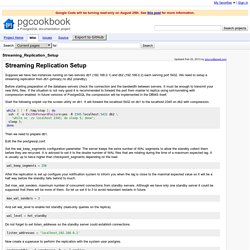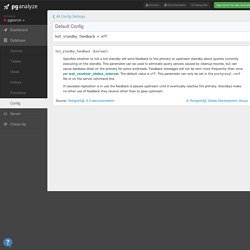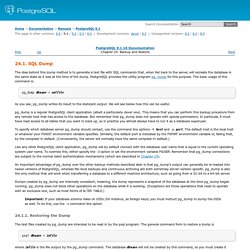

Tektastic: Why I Like PostgreSQL. Today I gave a short presentation at work about PostgreSQL, and why I much prefer it to MySQL.

PostgreSQL vs MySQL: Eternal Battle I may be misreading this, but it seems that there is a recent trend within startups to move away from MySQL, probably thanks to folks like Heroku on one side (who use PostgreSQL to the extreme, and help and contribute to it's development), vs folks like Oracle on the other side, tainting the "open source pureness" of MySQL :) At my work we currently use a mid-sized MySQL 5.1 Percona instance, which is holding up quite well I must admit. Both PostgreSQL and MySQL have definitely converged to cover most features that people want, but my leaning is still towards PostgreSQL. I just agree with it's focus on data integrity, recovery, constraints, extensibility, while some of the early decisions in MySQL's design do not agree with me at all (like truncating long strings, 1/0 instead of booleans, ambiguous group by, etc).
PostgreSQL Basics Configuration. tAp's blog: pg_dump: Error message from server: ERROR: canceling statement due to conflict with recovery. Streaming_Replication_Setup - pgcookbook - a PostgreSQL documentation project. Suppose we have two instances running on two servers db1 (192.168.0.1) and db2 (192.168.0.2) each serving port 5432.

We need to setup a streaming replication from db1 (primary) to db2 (standby). Before starting preparation of the database servers check the connection and the bandwidth between servers. It must be enough to transmit your new WAL files. If the situation is not very good it is recommended to forward the port from master to replica using ssh-tunneling with compression enabled. In future versions of PostgreSQL the compression will be implemented in the DBMS itself. Start the following sniplet via the screen utility on db1. While [ ! Then we need to prepare db1. Streaming_Replication_Setup - pgcookbook - a PostgreSQL documentation project. Hot_standby_feedback Postgres Config · pganalyze. Hot_standby_feedback (boolean) hot_standby_feedback configuration parameter Specifies whether or not a hot standby will send feedback to the primary or upstream standby about queries currently executing on the standby.

This parameter can be used to eliminate query cancels caused by cleanup records, but can cause database bloat on the primary for some workloads. Feedback messages will not be sent more frequently than once per wal_receiver_status_interval. Pg_dump. Dbname Specifies the name of the database to be dumped.

If this is not specified, the environment variable PGDATABASE is used. If that is not set, the user name specified for the connection is used. -a --data-only Dump only the data, not the schema (data definitions). This option is only meaningful for the plain-text format. -b --blobs Include large objects in the dump. -c --clean Output commands to clean (drop) database objects prior to outputting the commands for creating them. -C --create Begin the output with a command to create the database itself and reconnect to the created database. -E encoding --encoding=encoding Create the dump in the specified character set encoding. -f file --file=file. SQL Dump. The idea behind this dump method is to generate a text file with SQL commands that, when fed back to the server, will recreate the database in the same state as it was at the time of the dump.

PostgreSQL provides the utility program pg_dump for this purpose. The basic usage of this command is: pg_dump dbname > outfile As you see, pg_dump writes its result to the standard output. We will see below how this can be useful. pg_dump is a regular PostgreSQL client application (albeit a particularly clever one). To specify which database server pg_dump should contact, use the command line options -h host and -p port. Like any other PostgreSQL client application, pg_dump will by default connect with the database user name that is equal to the current operating system user name.